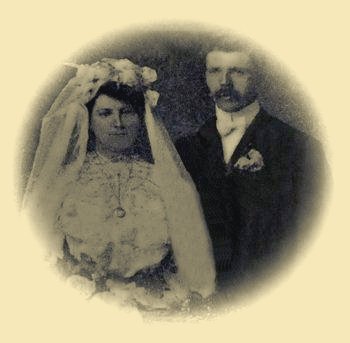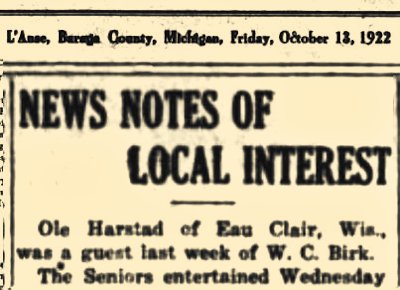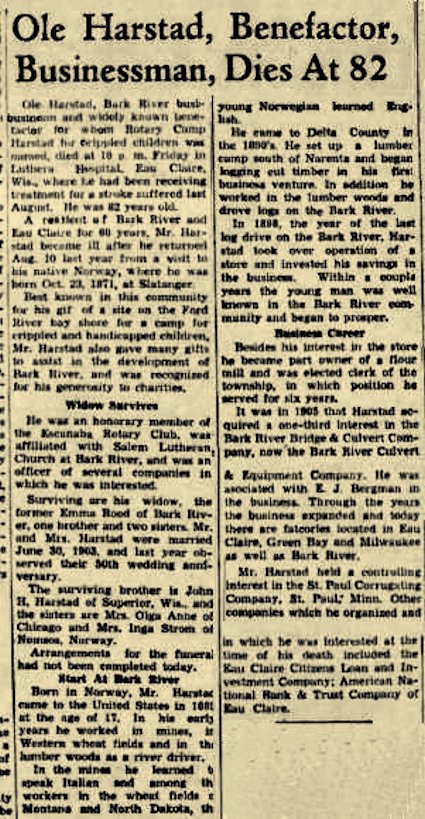Bio: Harstad, Ole Andreas (23 Oct 1871 - 30 Apr 1954
Contact: History Buffs
----Sources: Bark River Bridge & Culvert Company, pages 484 - 485; “Memories That Linger: Bark River Bicentennial 1871-1971”; Michigan Marriage Records, Eau Claire, Wis. Leader Telegram; Federal Census Records
Surnames: Bergman, Gasman, Harstad, Rood,
Ole Andreas Harstad was a familiar patron of the Greenwood, Wisconsin Central Hotel and his signature appears many times in their ledger.

Ole Andreas & Emma Rood (1903)
Ole Harstad arrived in the United States from (Flatanger kommune, Nord-Trøndelag fylke) Norway in 1889, when he was 17. He worked in the mines for 1½ years. Working with the Italians, he learned to speak their language more than English. He looked for a job that would give him more contact with people that spoke English, so he went west to Montana & North Dakota where he followed the harvesting crew during the summer & late fall.
In December, he started back to Minneapolis on the train. About a mile from
town a blizzard stopped the train, which did not move for 2 days. Yet Ole
got off the train & walked to town. He believes the only reason he survived
was because of his experience in mountain climbing, which gave him endurance
& having been a sailor, which gave him a sense of direction.
After a few days in Minneapolis, he went to Ironwood, Michigan & worked in
the Ashland Mine for 6 months. He learned to speak & write English. He
developed a cough from the mine work & a doctor advised him to do outdoor
work.
He secured a job at a saw mill, working from 3 a.m. until dark, piling
lumber. He made 7 cents a 1000. He worked in Ironwood until the mill closed.
He had a map of Delta County & saved enough money to buy some land south of
Narenta in 1893. He logged & cut timber. There was almost no market for
hardwood & it was nearly impossible to sell Hemlock.
He drove logs on the Bark River for 3 years, working for Gasman & Bergman.
In 1896, he was foreman of a lumber camp on the Hannahville Indian
Reservation.
Many 1000s of logs were driven down the Bark River & Ole saw as many as 8
ships loading ties & posts in the Bay.
The last log drive was in 1898.
Ole invested his savings of $400 & took over operating the Rood Store in
1898. He boarded for $16 a month & slept in the store. Ole was unable to
save very much of his earning for himself because his father had died
shortly after he left home, which made it necessary for him to help support
his mother & 7 children, younger than himself.
Ole was elected Township Clerk in 1899 & served for 6 years.
In 1905, Ole got a 3rd partnership with Bergman in Bark River Bridge &
Culvert Co.
He sold the store in 1907 & concentrated on the culvert productions.
“Memories That Linger: Bark River Bicentennial 1871-1971--with minor
changes"
*************************
1900 Federal
Census, Bark River township, Delta, Michigan, United States, Sheet Letter:
B, Sheet Number: 2
Ole Harstead, 29 yr. old (b. 23 Oct 1871)
white male who immigrated from Norway in 1889
Occupation: General
Merchandise Merchandiser
Location: ED 33 Bark River township, Delta, Michigan, United States
Father's Birthplace: Norway; Mother's Birthplace: Norway
*************************
Ole & Martin Rood came to Bark River in November 1882 & bought a farm from L.D. McKenna, the 1st owner.
Ole’s daughter, Ellen, married Carl Sandell & lived on the farm until her
death.
Afterwards her son Glenn took over the farm.
Ole & Martin were owners & operators of a Gist & Flour Mill in Bark River in
1896. An elevator to the flour mill in 1898.
People would come for mile around, even from Stephenson, Michigan, to have
the flour ground. The tall mill stood as one of the landmarks of the
village. It was razed to make way for the relocation of US 2 through Bark
River.
In 1898, Ole built a grocery & dry goods store. It was located on the corner
Main Street & the North Road. It was razed so a new structure, Adams Grocery
Store, could be built. Ole & Martin were so occupied with the mills & other
activities that they persuaded Ole Harstad to manage the store for them.
Harstad had married, Ole and Andrine Erlandson Rood's daughter, Emma.
(Information taken from - Memories That Linger: Bark River Bicentennial
1871-1971)
*************************
BioM: Rood, Emma (30 Jun 1903)
Michigan Marriages, 1868-1925
Groom: Ole Harstad, 31
yr. old male born in Norway
Location: Bark River, Delta, Michigan
Father: Iver Harstad
Mother: Gurn Hagen
Bride: Emma Rood, 21 yr. old born in Michigan
Father: Ole Rood
Mother: ?
*************************
In 1905, he Edward John Bergman & Ole Harstad bought the patent rights to
manufacture culverts, the 1st ones were made in 1906 in the shed attached to
the flour mill. This was the beginning of the Bark River Bridge & Culvert
Company. Information taken from -
Memories That Linger: Bark River Bicentennial
1871-1971.
Bark River Bridge & Culvert Company, pages
484 - 485
Bark River Bridge &
Culvert Company. The business of this concern was started as a partnership
between E. J. Bergman and Ole Harstad, at Bark River, Michigan, in 1906.
After three years of successful business there, a branch house was
established in Eau Claire, with Ole Harstad as proprietor and general
manager. The company have plants in both cities each covering about an acre
of ground with side track and railroad facilities.
Until the latter
years of the 19th century, wood had been the commonest material for bridges
and culverts. Its cheapness and general availability had recommended it to
road superintendents with scanty appropriations and long miles of roadway.
Frequent repairs and renewals had of course been necessary, but until the
sharp rise in price and decline in quality of lumber, which were attendant
upon the depletion of the forests, these expenditures had been little
regarded. Now, however, it came to be recognized that a bridge or drain made
from a material which would last only five or ten years, was a poor
investment; and road builders turned to other forms of construction, and the
corrugated culverts are now fast taking the place of all other material.
In 1906 there was placed on the market a product which chemical analysis showed to be of a purity never before attained. It was given the name of American Ingot Iron. This metal combines the best quality of steel and wrought iron, and avoids the imperfections of both. It is ductile and tough and will stand the most severe bending and manipulation without a flaw. It will weld readily, and has a high degree of electrical conductivity. It has a homogeneous and finely crystalline structure, and its density is slightly greater than that of either wrought iron or steel. Practical experience has shown it to be resistant to corrosion to a greater degree than any commercial metal of which iron is the base. Another consideration of scarcely less practical importance, is the fact that American Ingot Iron takes a heavy coat of galvanizing and retains it tenaciously. Pure iron dissolves in molten zinc very much less than does steel. For this reason, the spelter coating applied to it contains a minimum of dissolved iron, and resists disintegration to a remarkable degree. It is doubtless if in the progress of time and invention, two discoveries were ever made which so exactly supported and completed one another as those of the corrugated culvert and American Ingot iron, of which the Bark River Bridge & Culvert Company have the agency in northern Wisconsin and upper Michigan.

Obit: Harstad, Ole Andreas (23
Oct 1871-30 Apr 1954)
Birth: 23 Oct 1871 in Flatanger kommune,
Nord-Trøndelag fylke, Norway
Death: 30 Apr 1954 (aged 82) in Eau Claire, Eau Claire County,
Wisconsin
Burial: Bark River Cemetery, Bark River, Delta County, Michigan


